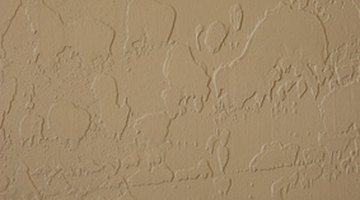How to Remove a Heavy Wall Texture
As an alternative to paint, wall texture is used to create an interesting, sometimes exotic look on walls and to hide the flaws of less-than-perfect walls. If you find the texture on your walls is too heavy, or you just don't like it anymore, you can remove it by yourself.

Things You Will Need
- Plastic drop cloths
- Push pins
- Painter's tape
- Screwdriver
- 4-inch scraper or larger
- Orbital sander (optional)
- Pump-up sprayer
- Drywall sanding pole
- 100-grit drywall sandpaper
It is important to prepare the room, because removing the texture will be a messy job.
-
Remove as much furniture as possible from the room. Completely cover the floor and light fixtures with plastic and use painter’s tape to hold it in place. Use pushpins to hold plastic over the doors. Use a screwdriver to remove all the outlet covers. Bring in a light to work by if you need one.
-
Check your scraper to make sure the blade is sharp enough to scrape through the paint. Purchase a new blade at your local home improvement store or paint supply store if necessary. Scrape the surface of the walls to remove the paint. This will be a slow process. Speed up the pace by using an orbital sander to remove the paint; be sure the sander has a vacuum attachment to help reduce the amount of dust you'll have to clean up later.
-
Fill a pump-up sprayer with water. Pump the sprayer to create pressure and spray the bare drywall compound on the walls that was exposed after scraping off the paint. Use just enough water to soak the compound, but do not soak the drywall. Work at one small section at a time and use the scraper to remove the drywall compound. Spray the wall frequently to keep the compound moist as you scrape.
-
Allow the walls to dry before sanding. Attach 100-grit sandpaper to the sanding pad on the drywall-sanding pole. Sand the walls to achieve a smooth finish if you are going to paint them. If you are planning to apply another texture, you will not have to sand the walls completely smooth.
Warning
Wear tight-fitting safety glasses and a respirator if you use an orbital sander.
Do not heavily soak the walls when wetting the compound. Use only enough water to get the compound to come off. Excess water can damage drywall.
References
Warnings
- Wear tight-fitting safety glasses and a respirator if you use an orbital sander.
- Do not heavily soak the walls when wetting the compound. Use only enough water to get the compound to come off. Excess water can damage drywall.
Writer Bio
Based in Oklahoma City, Debbie Tolle has been working in the home-improvement industry since 2001 and writing since 1998. Tolle holds a Master of Science in psychology from Eastern Illinois University and is also a Cisco-certified network associate (CCNA) and a Microsoft-certified systems engineer (MCSE).
Photo Credits
- wall texture image by MAXFX from Fotolia.com
- wall texture image by MAXFX from Fotolia.com
More Articles



